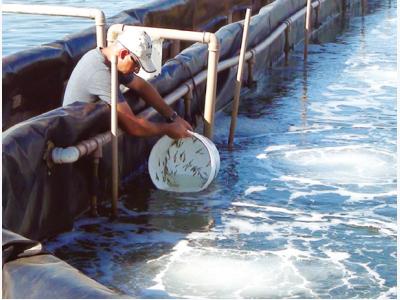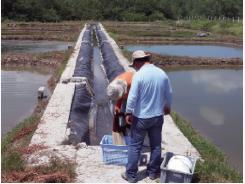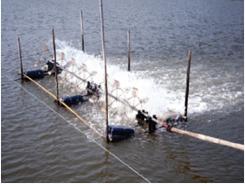Brazil study results encouraging for injector

Aeration in super-intensive shrimp culture
Shrimp stocked in raceways equipped with air injector aeration for a growout study achieved weekly growth rates similar to those reported in super-intensive systems in southern Brazil.
Biofloc technology systems represent a new alternative for shrimp culture. These systems utilize minimal to zero water exchange and improve water quality through the formation of a microbial community consisting of microorganisms that include bacteria, microalgae, protozoa and zooplankton. In addition to improved water quality, bioflocs also supplement shrimp diets.
The formation of biofloc is stimulated by the addition of a carbon source to maintain a carbon:nitrogen ratio ranging from 12:1 to 20:1, depending upon physical, chemical and biological interactions. These interactions are stimulated by increased rates of mixing and oxygenation.
In early stages of culture, the abundance of bacteria that use the dissolved organic matter in the environment for growth increases. Conversely, low oxygen concentrations can negatively influence the floc-forming microbial community and lead to poor water quality and reduced performance of the cultured animals.
Aeration in biofloc systems
Zero-exchange biofloc systems allow elevated stocking densities and production, but also require more dissolved oxygen, degassing and thorough mixing and circulation of the water column. Several aeration devices have been used in the systems. The most common aerators in super-intensive raceways are venturis and diffusers (air stones and tubes driven by blowers), while paddlewheel aerators are more common in lined ponds for intensive culture.
Recently, a new type of air injector has been used in raceway systems. These injectors use only a centrifugal pump to recirculate the water while naturally aspirating ambient air, sheering it into the water column at an air:water ratio of 3:1. This sheering produces fine microbubbles and high transfer rates, and eliminates the need for pure oxygen supplementation.
Mounted on the bottoms of raceways, the injectors mix the water vertically while creating a horizontal current to keep solids in suspension and assist in the distribution of feeds. The injectors’ air intakes or “snorkels” can also be built into a manifold for the ability to select and adjust the source and location of the air being injected.
Utilizing the hot air accumulated near the top of a greenhouse allows for increased heating of the water, while drawing fresh air from outside aids in the reduction of carbon dioxide build-up in the greenhouse. By performing multiple tasks efficiently, these injectors can be a good alternative for super-intensive, zero-exchange biofloc systems.
Study setup
To compare the performance of the air injectors with that of the diffuser tubes and paddlewheel aerators typically used in Southern Brazil, nursery and growout phase studies were performed at the Marine Station of Aquaculture of the Federal University of Rio Grande in southern Brazil.
Shrimp were fed commercial diets with 38 and 40 percent crude protein, with feeding rates adjusted according to weekly growth. For both studies, organic fertilization employed molasses from sugar cane as a carbon source. Following daily measurements, pH and alkalinity were corrected with calcium hydroxide whenever the pH was below 7.0 and alkalinity was equal to or less than 100 mg calcium carbonate/L.
Nursery phase study
Pacific white shrimp (Litopenaeus vannamei) postlarvae from a commercial hatchery in Canguaretama, Rio Grande do Norte State, Brazil, were stocked at 2,500 shrimp/m3 in two, 70-m3 tanks operated with zero water exchange and raised for 30 days until each individual reached 1.0-g weight. The tanks were filled with a mixture of sand-filtered seawater with 28-ppt salinity and 5-ppt groundwater, and inoculated with biofloc-rich water from a previous growout study at 10 percent of the total volume.
Table 1: Water quality parameters in a nursery phase biofloc system raising white shrimp
| Parameter | Injectors | Air Hoses |
| Temperature (°C) | 28.9 | 27.2 |
| Dissolved oxygen (mg/L) | 5.77 | 6.05 |
| pH | 7.74 | 7.63 |
| Salinity (ppt) | 23.1 | 23.8 |
| Total ammonia-nitrogen (mg/L) | 0.70 | 0.18 |
| Nitrite-nitrogen (mg/L) | 1.90 | 0.72 |
| Nitrate-nitrogen (mg/L) | 4.83 | 5.92 |
| Phosphate (mg/L) | 1.40 | 1.80 |
| Alkalinity (mg/L) | 198.00 | 101.67 |
| Total suspended solids (mg/L) | 253.00 | 328.33 |
This study compared the performance of the air injectors, driven by a 2-hp centrifugal pump, with a commercial microperforated air diffuser hose driven by a 2-hp blower. In the injector treatment, the injectors were positioned parallel to the direction of flow along the bottom of each tank wall. The diffuser hoses were cut into 10-cm lengths, connected by polyvinyl chloride pipe and placed every 1.5 m2 in the bottoms of the tanks.
Table 2: Zootechnical parameters of L.vanamei in a nursery phase biofloc system
| Parameter | Injectors | Air Hoses |
| Initial weight (g) | 0.05 | 0.03 |
| Final weight (g) | 0.96 | 0.71 |
| Survival (%) | 98.8 | 80.7 |
| Feed-conversion ratio | 1.22 | 1.46 |
The treatments were performed in duplicate. Water quality parameters were maintained within normal ranges for the culture of L. vannamei in both treatments (Table 1). The better growth and survival were observed in the injector treatment, with 0.96 g and 98.8%, respectively (Table 2).
Growout study
An 86-day growout study was performed in two lined raceways to compare the air injectors to paddlewheel aerators. In the air injector system, 14 air injectors were positioned parallel to the direction of flow along the bottom of each raceway and driven by a 3-hp centrifugal pump. In the paddlewheel system, a 2-hp paddlewheel aerator was used.
Table 3: Water quality parameters in a growout phase biofloc system raising white shrimp
| Parameter | Injectors | Paddlewheel |
| Temperature (°C) | 25.4 | 23.4 |
| Dissolved oxygen (mg/L) | 7.21 | 7.30 |
| pH | 7.78 | 7.84 |
| Salinity (ppt) | 20.3 | 21.3 |
| Total ammonia-nitrogen (mg/L) | 0.24 | 0.28 |
| Nitrite-nitrogen (mg/L) | 4.12 | 1.88 |
| Nitrate-nitrogen (mg/L) | 11.60 | 18.00 |
| Total suspended solids (mg/L) | 458.00 | 662.00 |
The raceways were stocked at 591 shrimp/m3 with 0.82-g L. vannamei juveniles. The raceways were each filled to 237 m3 with a mixture of sand-filtered seawater (185 m3, 28-ppt salinity), groundwater (52 m3, 5 ppt) and biofloc-rich water (2 percent of the total volume) from a nursery study. Water quality parameters were maintained within normal ranges for the culture of L. vannamei (Table 3).
Table 4: Zootechnical parameters of L.vanamei in a growout phase biofloc system
| Parameter | Injectors | Paddlewheel |
| Initial weight (g) | 0.82 | 0.82 |
| Final weight (g) | 9.42 | 8.55 |
| Feed-conversion ratio | 1.94 | 3.95 |
| Weekly growth rate (g) | 0.71 | 0.64 |
| Survival (%) | 73 | 51 |
| Biomass (kg) | 770.87 | 448.81 |
| Productivity (kg/m²) | 3.25 | 2.06 |
| Productivity (kg/m³) | 4.06 | 2.57 |
The shrimp in the injector treatment showed final average weights of 9.42 g, while those whose raceways received paddlewheel aeration reflected weights of 8.55 g. At 1.94, feed-conversion ratios were much better than the 3.95 recorded for the paddlewheel treatment.
However, the survival rate in the air injector trial was 73 percent versus 51 percent in the paddlewheel trial. Apparently the paddlewheel physically killed the shrimp, as during the trial, dead shrimp were found close to the aerator. This significantly affected final productivity and biomass values.

In this first trial with air injectors in biofloc systems, the authors compared the aeration performance of the injectors with that of the diffuser tubes and paddlewheel aerators typically used in southern Brazil.
At 0.71 and 0.64 g, respectively, the weekly growth rates for the injector and paddlewheel treatments were similar to those reported in super-intensive systems in Southern Brazil, but it is important to highlight that at the end of culture, low temperatures near 20° C were recorded.
Perspectives
In this first trial with air injectors and bioflocs, the results were encouraging, as productivity exceeded 4 kg/m3. On the other hand, paddlewheel aerators may be a better choice for intensive systems in ponds and apparently are not intended for super-intensive raceway systems. In general, the detected temperatures were 2° C higher in the air injector system. This can be explained by the difference in injecting air into the bottom of the tanks versus casting water from the surface into the air.
Có thể bạn quan tâm
Phần mềm

Phối trộn thức ăn chăn nuôi

Pha dung dịch thủy canh

Định mức cho tôm ăn

Phối trộn phân bón NPK

Xác định tỷ lệ tôm sống

Chuyển đổi đơn vị phân bón

Xác định công suất sục khí

Chuyển đổi đơn vị tôm

Tính diện tích nhà kính

Tính thể tích ao hồ




 Proper water circulation in aquaculture ponds, Part 2
Proper water circulation in aquaculture ponds, Part 2  The inevitable pH fluctuations of aquaculture pond water
The inevitable pH fluctuations of aquaculture pond water